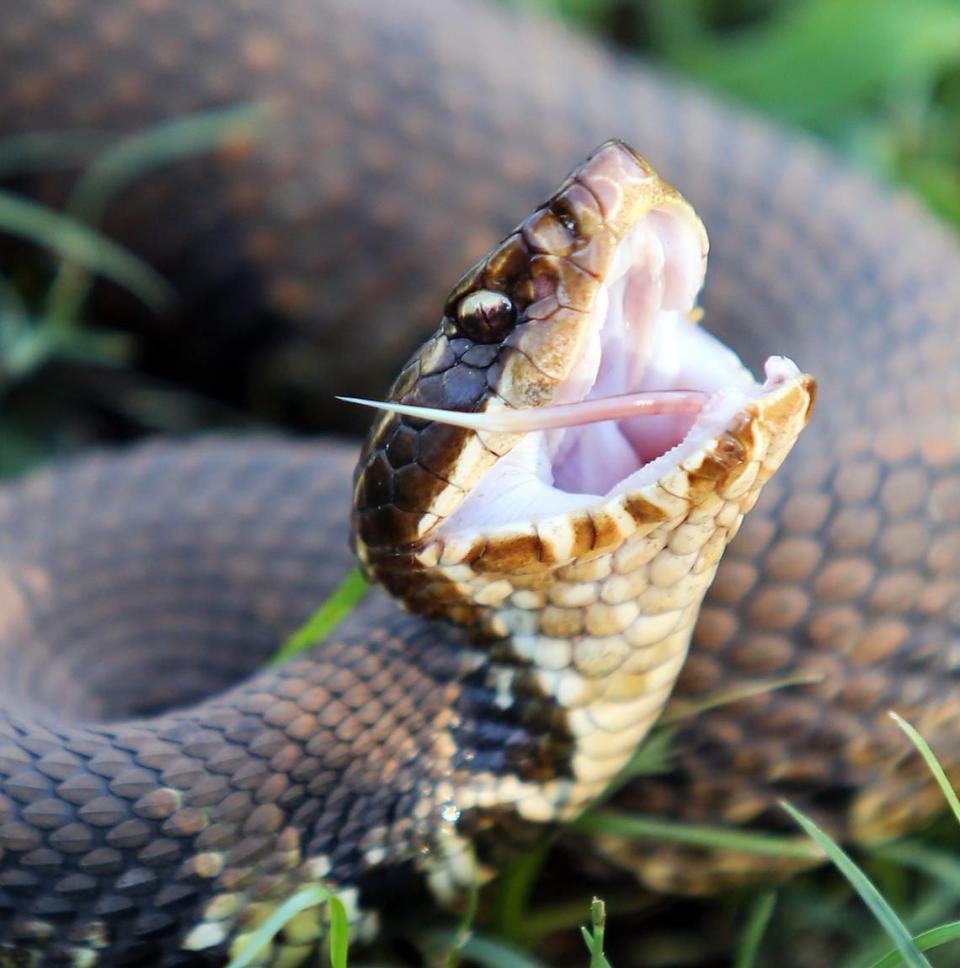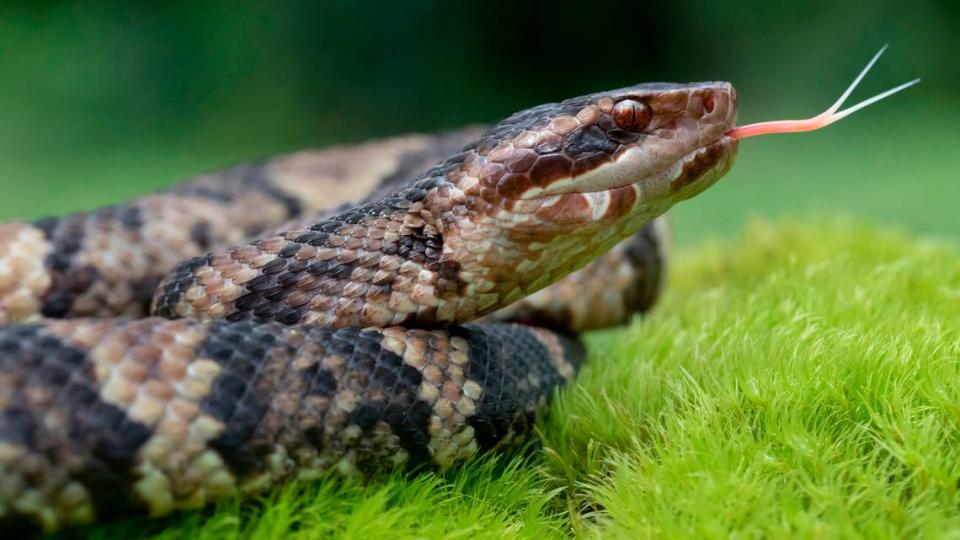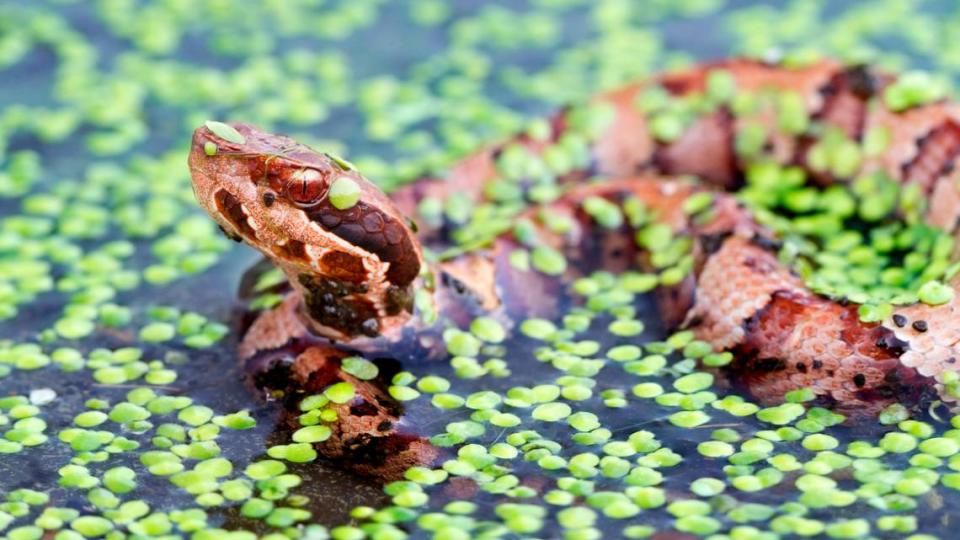Cottonmouths are another venomous snake in the Triangle. Here’s how to identify them.
Cottonmouth snakes, also known as water moccasins, are cousins of copperheads — a venomous snake frequently seen in the Triangle.
Although cottonmouths are primarily found in the eastern part of the state, they can be spotted in Johnston County and parts of Wake County.
And when they’re spotted, people get excited.
“When people see cottonmouths in Wake County, you’ll see about it on those snake Facebook groups that people like me are a part of,” said Kevin Bischof, a park superintendent with the N.C. Division of Parks and Recreation. “People don’t post about copperheads because you see them all the time. Cottonmouths are around here, but you don’t see them too much.”
Cottonmouths are one of the six venomous snakes found in North Carolina.
Though it’s unusual to see a cottonmouth in the Triangle, you should still know how to identify it and stay safe from a bite.
What does a cottonmouth snake look like?
The cottonmouth’s name-defining characteristic includes its white (or very pale colored) mouth.
The snake’s mouth is a stark contrast to the its darker colored, thick body, N.C. Park’s Bischof said. The snake gapes, revealing its pale mouth, to defend itself.
Cottonmouths are also heavier bodied, which can distinguish it from other nonvenomous watersnakes, he said.
Here are some defining characteristics of cottonmouths, according to the NC Wildlife Resources Center:
They have facial pits for sensing infrared radiation (or heat).
Their heads are distinctly wider than their necks.
They have a dark bar on both sides of their heads that spans from the eyes to the angles of their jaws.
They have nine large scales on the crowns of their heads.
Their pupils are vertically elliptical.
They’re patterned with dark crossbands that have light olive or brown centers. The crossbands are widest on the sides of the snake and narrowest on the top. (Note: This is the opposite of most nonvenomous watersnakes that are often mistaken for cottonmouths.)
Young cottonmouths have bright green (sometimes yellowish) tail tips. The details of the cross band pattern are most evident when they’re young, while older cottonmouths can be completely dark and unpatterned.
They do not have rattles on the ends of their tails.
Source: ncwildlife.org

How severe are cottonmouth snake bites?
Cottonmouths are venomous snakes. Their bites can be severe, but they’re generally not as bad as other North Carolina snakes, especially rattlesnakes. (For a full explainer on North Carolina’s rattlesnakes, visit newsobserver.com/news.)
Generally, cottonmouth bites have about the same severity level as copperhead bites, according to NC Poison Control.
Here’s an excerpt from previous N&O reporting on copperhead bites:
Copperhead snake bites are rarely fatal to humans, but they can be painful and expensive to treat.
According to the NC Poison Control in Charlotte, copperhead bites can be “severe,” but generally are not as bad as bites from other venomous North Carolina snakes. About half of all copperhead bites result in only mild swelling and pain, according to the center.
The center says it receives about 10 times the number of calls about copperhead bites than all other snakes combined.
“Antivenom is not always required to treat a copperhead bite, but it is important to be evaluated by a physician with expertise in treating venomous snakebites in order to make that determination,” Dr. Eugenia Quackenbush, an emergency physician with UNC Medical Center, told The News & Observer.
Call the Carolinas Poison Center at 1-800-222-1222 if you have questions about a snakebite.
And to learn more about going to the emergency room (and how to know if you need antivenom) for a copperhead bite, visit newsobserver.com/news.
Where can you find cottonmouths in NC?
Cottonmouths can be found on the eastern half of North Carolina.
Their range includes the eastern portion of Wake County and all of Johnston County. You won’t find cottonmouth snakes in Orange, Durham or Chatham counties, according to range maps published by NC Poison Control and NC Wildlife Resources Commission.

Bischof isn’t aware of any cottonmouth bites in N.C. State Parks, he said.
Cottonmouth snakes swim, and sometimes need to rest
Cottonmouth snakes, often nicknamed “water moccasins” as a slang term, are watersnakes. They prefer fresh water, though they can also be found on land, per NC Poison Control.
“When swimming, they’re much more buoyant than nonvenomous watersnakes,” Bischof said. “People have said to me that they saw a snake that looked like a balloon floating on the water.”
If you see a cottonmouth swimming towards you, it’s not to attack, he said. Any swimming snake species needs to take a rest, and they often look for floating objects, like logs or even boats, to rest on.
“What people should do if they’re in their boat is just flip them back out into the water,” he said. “I wouldn’t expect anyone to let them sit and rest.”
Because these snakes are cold blooded, they’ll often hang on sunny branches to nap and warm up. If someone startles a snake while it’s sleeping, its first defense is to go back into the water.
“People tell all these stories of snakes jumping into their boats or lunging at them — snakes don’t really jump. They’re just trying to get away from what they think is a dangerous situation,” Bischof said.

How to avoid a cottonmouth snake bite
The best way to avoid a snake bite (cottonmouth or otherwise) is to leave the snake alone, N.C. Parks’ Bischof said. Even though cottonmouths are often laid back snakes, they still might bite if you feel threatened.
“Sure, cottonmouths can bite if you harass and poke, they’re no different than people,” he said. “You start harassing them, and they’re gonna call your mama an ugly name.”
There are some other precautions to take during NC’s snake season to avoid bites. Here’s what NC Poison Control says to do:
Watch your step, and watch where your hands go. Don’t reach where you can’t see, and don’t step over an object without knowing what is on the other side.
Wear sturdy boots or shoes when you’re outside, especially when gardening or hiking.
Wear gloves when gardening.
Use a flashlight at night when you’re outside, even when you know the area well.
Back away slowly if you see a snake. Don’t try to pick it up or kill it. It can bite you while you’re trying to grab it. A dead snake, or even the detached head of a snake, can still bite because of the bite reflex.
Source: cdn.atriumhealth.org

How to tell the difference between a cottonmouth and a watersnake
Watersnakes are harmless to humans, as they don’t have fangs and venom glands.
There are at least 10 things to look for that can help you differentiate between the two snakes. Here are characteristics of watersnakes, according to the NC Wildlife Resources Commission:
Watersnakes…
don’t have heat-sensing facial pits that vipers do.
have two rows of scales underneath the tail (cottonmouths have one).
have the widest part of the dark crossbands on their backs.
have narrower heads (though they can be flattened to appear larger).
lack yellow tail tips when they’re young.
have boldly striped upper lips (while cottonmouths have plain ones).
have round pupils (while cottonmouths have vertically elliptical ones).
do not gape their mouths.
will dive beneath water to escape predators (while cottonmouths swim across the surface).
occur statewide, not just in the coastal plain areas of the state.
Source: ncwildlife.org
To learn more about identifying snakes, you can check out snake programs at NC’s local state parks, Bischof said. Check for programming on ncparks.gov and find program schedules listed under “Things to Do.”
Ask the N&O
Have a question you’d like answered? Or maybe a tip or story idea you’d like to share? The News & Observer’s Service Journalism team wants to hear from you. For useful and practical information from our staff, reach us by submitting questions to our form or sending an email to ask@newsobserver.com.

 Yahoo Movies
Yahoo Movies 
